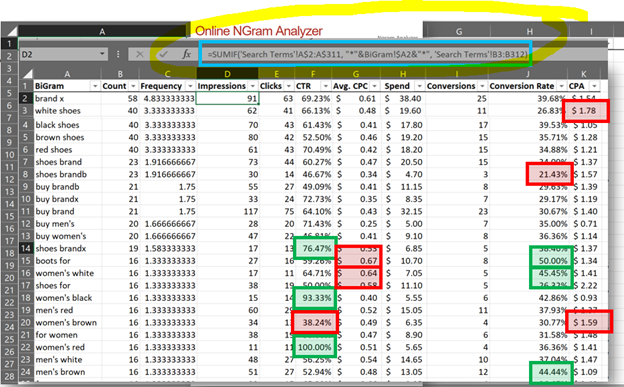If you are looking for supplemental volume and have a website with multiple pages of content or metadata, Dynamic Search Ads (DSA) should be part of your holistic SEM strategy to drive incremental query coverage.
If you’re not yet sold on the benefits of Dynamic Search Ads (DSA), consider the following:
- DSA complements your existing search campaigns by filling gaps your keyword-based campaigns can’t reach.
- This feature automatically creates ads based on the latest content of your website and helps keep your ads relevant by serving ads to the right person at the right time.
- It increases search term coverage by helping you identify new queries and match types.
- Utilization reduces the burden of bulky operations by skipping keywords and repetitive ad copy creation.
In this column, you’ll learn how to get creative with keyword mining through Dynamic Search Ads using N-gram analysis, and also find additional best practices to make your campaigns a success.
Tracking Keyword/Ad Copy Performance
The key to tracking DSA terms is to be both reactive and proactive. The DSA algorithm is smart, but not omniscient.
Smart optimization strategies will train the DSA algorithm to match relevant search terms and generate quality traffic.
Not only are the settings in the DSA campaign important, but so is the website content that the auto targets uses to match to search queries.
Use the Keyword Planner or Bing Ads Intelligence to see what keywords Bing’s web crawler “sees” on these website pages. Add negative keywords, auto-target exclusions, etc. as necessary.
As a proactive measure, copy negative keywords from your standard search campaigns to DSA. Negatives List in the Shared Library is perfect for this.
Proactively block irrelevant pages on your website with exclusions – contact us pages, blog content that won’t drive the right types of traffic, etc.
In addition to looking at the search terms, be sure to review the ad headlines that were generated by DSA.
Are the headlines relevant? You can find negative keyword ideas here, too!
Mining New Keywords with DSA
Excel is your friend. Aggregate as much data as possible using pivot tables – by auto-target, landing page, search term, etc.
My favorite technique is to enhance your analysis with N-grams.
N-grams are something we are starting to hear more and more about in the paid search industry.
Essentially, this is an easy way to break down the search terms into one-word (unigram), two-word (bi-gram), and three-word (trigram) phrases to aggregate data into meaningful “chunks.”
Getting Started with N-Gram Analysis
You will need…
Excel: With basic skills to create formulas and leverage the SUMIF function.
Search Term Report: From Bing Ads DSA campaign (or any search term report for any campaign. This process can be used across the board.).
N-Gram analyzer: Google includes n-gram analysis in their Data Studio product, but there are other free N-gram analyzer resources available online.
20 minutes of your time to set up the spreadsheet.
Ngam Analysis in 8 Steps
- Pull Search Term report for DSA campaign.
- Copy/paste Search Terms into Ngram analyzer. Choose Bi-grams for two-word phrases, or Tri-gram for three-word phrases. SUBMIT.
- Copy/paste output into a new tab in Excel. Name it BIGRAM or TRIGRAM. (You can do the same for unigrams – single words, but for this example, we’re just going to do bigrams – two words).
- In the BIGRAM worksheet, ad columns for Impressions, Clicks, Spend, Conversions… you can also create columns for CTR, CPC, CPA, and CVR – just remember to insert the basic formulas to calculate this data.
- For Impressions, clicks, spend, and conversions – you need to insert a SUMIF formula.
- This looks at the bi-gram or uni-gram and scrubs against the original list of search terms. If there’s a match, then the data for that search term is summed.
- Create your SUMIF (see example below).
- Now, we can see the total data for any search term that contains these two-word phrases. Now instead of just one or two impressions and a single click or conversion, there is significant data to review and analyze.

Why Go Through the Trouble of Running a Report Like This?
Now you can quickly bundle those one-impression and one-click search terms together into meaningful data sets.
Since this data is pulled from a Search Query report, you are effectively mining relevant keywords that people are actively using to search, but you are not yet bidding on.
With aggregate data, you can spot positive trends in CTR and conversion rates, for example, which would lead you to take the next step of creating targeted keywords containing these two-word or three-word phrases.
You can also spot negative trends in CTR, CPC, conversion rate, and CPA, which would lead you to take the next step of creating negative keywords containing these two-word phrases.
Needless to say, DSA is a powerful tool for keyword mining, optimization, and expansion opportunities through existing search queries.
More Dynamic Search Ads Best Practices
- Make sure your website has plenty of relevant web content, products, and services to support the Dynamic Search Ads learning algorithm.
- Start creating “target all” webpages + add on a variety of auto targets using the most popular categories of your website.
- Add existing negative keywords to the shared library. This will help control relevancy and costs as the algorithm is learning.
- Add site exclusions (parts on the website that do not drive meaningful opportunities).
- Use Ad Extensions to improve CTR & CVR.
- Use enhanced CPC over Manual CPC, or test various auto-bidding strategies to see which performs best for your campaigns. Monitor how your bidding strategy works with DSA and adjust it if needed.
- Assign your DSA campaigns with your current remarketing audiences to boost up performance.
- Keep in mind, DSA is a learning algorithm. It takes at least three to five days of DSA ads being live for the Auto Targets to sync with your site and synch with the back-end of the platform you are advertising on.
- Add existing negative keywords to the DSA campaign.
- Use Ad Extensions to improve CTR.
More Resources:
- 5 Innovative PPC Tactics to Try Today
- Remember When Keywords Mattered Most in PPC? Well, That’s Changing
- PPC 101: A Complete Guide to PPC Marketing Basics
Featured image: I000s_pixels/Shutterstock


